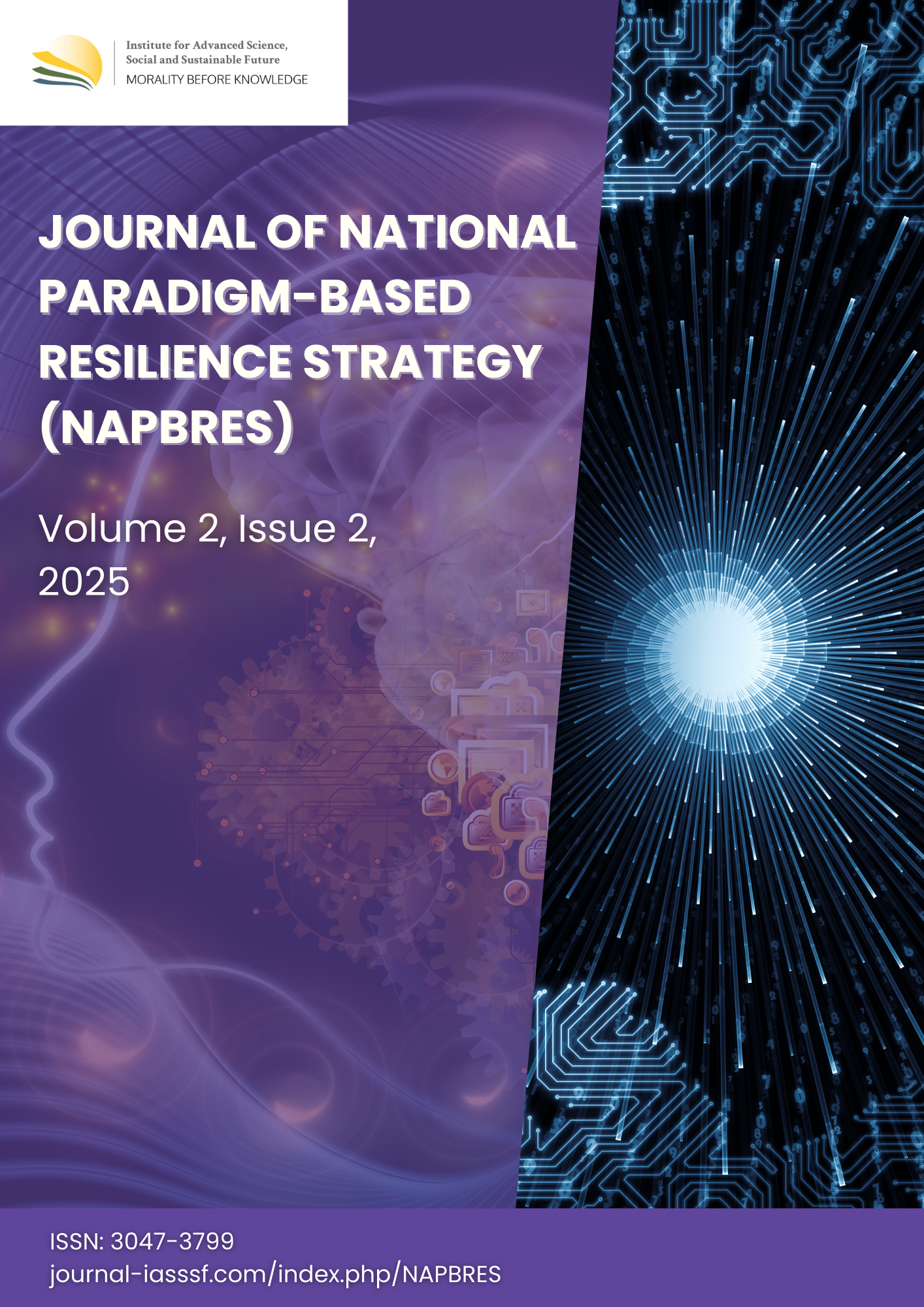Integration of cyber defense and conventional security in addressing non-military threats in the digital era
DOI:
https://doi.org/10.61511/napbres.v2i02.2025.2106Keywords:
conventional security, cyber defense, digital era, non-military threatAbstract
Background: The development of digital technology has transformed the landscape of threats to national security, with non-military threats, including cyberattacks, digital terrorism, and disinformation, becoming increasingly urgent. These threats have the potential to undermine social, economic, and political stability. This study aims to analyze the integration of cyber and conventional defense in strengthening national resilience against non-military threats. Method: This research employs a qualitative approach, analyzing literature and policies of national security institutions regarding non-military threats. Primary data were obtained through a literature review of journals and articles accessed via SCOPUS. The study began with brainstorming to identify topics, subthemes, and relationships between concepts. Findings: The results indicate that integrating cyber and conventional defense enhances the response to hybrid threats. Joint management of cyber and physical threats, along with sharing resources and information between agencies, enhances the effectiveness of responses to complex threats. Conclusion: This study concludes that integrating cyber and conventional defense systems is crucial for addressing threats in the digital age. Its success depends on clear policies, regulations, and strict oversight to ensure effective coordination between relevant agencies. Originality/Novelty of the Article: The article's originality lies in proposing an integrated defense model that combines conventional and cyber strategies to address hybrid threats, a topic that has not been extensively discussed in the literature.
References
Ahmed, M., Cox, D., Simpson, B., & Aloufi, A. (2022). ECU-IoFT: A Dataset for Analysing Cyber-Attacks on Internet of Flying Things. Applied Sciences (Switzerland), 12(4). https://doi.org/10.3390/app12041990
AL-Dosari, K., Fetais, N., & Kucukvar, M. (2024). Artificial Intelligence and Cyber Defense System for Banking Industry: A Qualitative Study of AI Applications and Challenges. Cybernetics and Systems, 55(2). https://doi.org/10.1080/01969722.2022.2112539
Bellanova, R., Carrapico, H., & Duez, D. (2022). Digital/sovereignty and European security integration: an introduction. European Security, 31(3). https://doi.org/10.1080/09662839.2022.2101887
Bellanova, R., & de Goede, M. (2022). Co-Producing Security: Platform Content Moderation and European Security Integration. Journal of Common Market Studies, 60(5). https://doi.org/10.1111/jcms.13306
Bellanova, R., & Glouftsios, G. (2022). Formatting European security integration through database interoperability. European Security, 31(3). https://doi.org/10.1080/09662839.2022.2101886
Bıçakcı, A. S., & Evren, A. G. (2022). Thinking multiculturality in the age of hybrid threats: Converging cyber and physical security in Akkuyu nuclear power plant. Nuclear Engineering and Technology, 54(7). https://doi.org/10.1016/j.net.2022.01.033
Binnar, P., Bhirud, S., & Kazi, F. (2024). Security analysis of cyber physical system using digital forensic incident response. In Cyber Security and Applications (Vol. 2). https://doi.org/10.1016/j.csa.2023.100034
Ding, M., Liu, W., Xiao, L., Zhong, F., Lu, N., Zhang, J., Zhang, Z., Xu, X., & Wang, K. (2022). Construction and optimization strategy of ecological security pattern in a rapidly urbanizing region: A case study in central-south China. Ecological Indicators, 136. https://doi.org/10.1016/j.ecolind.2022.108604
Faragallah, O. S., Afifi, A., El-Shafai, W., El-Sayed, H. S., Alzain, M. A., Al-Amri, J. F., & El-Samie, F. E. A. (2020). Efficiently Encrypting Color Images with Few Details Based on RC6 and Different Operation Modes for Cybersecurity Applications. IEEE Access, 8. https://doi.org/10.1109/ACCESS.2020.2994583
Ghelani, D. (2022). Cyber Security in Smart Grids, Threats, and Possible Solutions. CC-BY American Journal of Applied Scientific Research, 169.
Ghosal, A., & Conti, M. (2020). Security issues and challenges in V2X: A Survey. Computer Networks, 169. https://doi.org/10.1016/j.comnet.2019.107093
Guembe, B., Azeta, A., Misra, S., Osamor, V. C., Fernandez-Sanz, L., & Pospelova, V. (2022). The Emerging Threat of Ai-driven Cyber Attacks: A Review. In Applied Artificial Intelligence (Vol. 36, Issue 1). https://doi.org/10.1080/08839514.2022.2037254
Goffer, M., Uddin, M., Kaur, J., Hasan, S., Barikdar, C., Hassan, J., Das, N., Chakraborty, P., & Hasan, R. (2025). AI-Enhanced Cyber Threat Detection and Response: Advancing National Security in Critical Infrastructure. Journal of Posthumanism. https://doi.org/10.63332/joph.v5i3.965
Hafeez, S., Khan, A. R., Al-Quraan, M. M., Mohjazi, L., Zoha, A., Imran, M. A., & Sun, Y. (2023). Blockchain-Assisted UAV Communication Systems: A Comprehensive Survey. IEEE Open Journal of Vehicular Technology, 4. https://doi.org/10.1109/OJVT.2023.3295208
Hameed, S. S., Hassan, W. H., Latiff, L. A., & Ghabban, F. (2021). A systematic review of security and privacy issues in the internet of medical things; the role of machine learning approaches. PeerJ Computer Science, 7. https://doi.org/10.7717/peerj-cs.414
Hou, J., Hu, C., Lei, S., & Hou, Y. (2024). Cyber resilience of power electronics-enabled power systems: A review. Renewable and Sustainable Energy Reviews, 189. https://doi.org/10.1016/j.rser.2023.114036
Irshad, R. R., Hussain, S., Hussain, I., Nasir, J. A., Zeb, A., Alalayah, K. M., Alattab, A. A., Yousif, A., & Alwayle, I. M. (2023). IoT-Enabled Secure and Scalable Cloud Architecture for Multi-User Systems: A Hybrid Post-Quantum Cryptographic and Blockchain-Based Approach Toward a Trustworthy Cloud Computing. IEEE Access, 11. https://doi.org/10.1109/ACCESS.2023.3318755
Jada, I., & Mayayise, T. O. (2024). The impact of artificial intelligence on organisational cyber security: An outcome of a systematic literature review. Data and Information Management, 8(2). https://doi.org/10.1016/j.dim.2023.100063
Kaur, R., Gabrijelčič, D., & Klobučar, T. (2023). Artificial intelligence for cybersecurity: Literature review and future research directions. Information Fusion, 97. https://doi.org/10.1016/j.inffus.2023.101804
Khan, A. R., Yasin, A., Usman, S. M., Hussain, S., Khalid, S., & Ullah, S. S. (2022). Exploring Lightweight Deep Learning Solution for Malware Detection in IoT Constraint Environment. Electronics (Switzerland), 11(24). https://doi.org/10.3390/electronics11244147
Khan, S. I., Ray, B. R., & Karmakar, N. C. (2024). RFID localization in construction with IoT and security integration. In Automation in Construction (Vol. 159). https://doi.org/10.1016/j.autcon.2023.105249
Kurnia, S. S., Rahman, Z., Cakranegar, D. I., Abdulla, S. I., Setiawan, D. A., Agustini, P. M., & Yenrizal. (2024). Effect of Counter-Narratives and Credibility of Sources on Emotional Response: A Study of Instagram and WhatsApp Followers. Journal of Intercultural Communication, 24(1). https://doi.org/10.36923/jicc.v24i1.170
Liebetrau, T. (2024). Problematising EU Cybersecurity: Exploring How the Single Market Functions as a Security Practice. Journal of Common Market Studies, 62(3). https://doi.org/10.1111/jcms.13523
Li, Y., Dai, J., & Cui, L. (2020). The impact of digital technologies on economic and environmental performance in the context of industry 4.0: A moderated mediation model. International Journal of Production Economics, 229. https://doi.org/10.1016/j.ijpe.2020.107777
Martin, C. (2022). Climate Change and Global Security: Framing an Existential Threat. AJIL Unbound, 116. https://doi.org/10.1017/aju.2022.39
Moyo, M., & Loock, M. (2021). Conceptualising a cloud business intelligence security evaluation framework for small and medium enterprises in small towns of the Limpopo Province, South Africa. Information (Switzerland), 12(3). https://doi.org/10.3390/info12030128
Nguyen, T. T., & Reddi, V. J. (2023). Deep Reinforcement Learning for Cyber Security. IEEE Transactions on Neural Networks and Learning Systems, 34(8). https://doi.org/10.1109/TNNLS.2021.3121870
Nimmy, K., Dilraj, M., Sankaran, S., & Achuthan, K. (2023). Leveraging power consumption for anomaly detection on IoT devices in smart homes. Journal of Ambient Intelligence and Humanized Computing, 14(10). https://doi.org/10.1007/s12652-022-04110-6
Paalo, S. A., Degraft Arthur, D., Dramani, A., & Adu-Gyamfi, S. (2024). Exploring hybrid security strategies in Ghana: State and private sector partnerships. African Security Review, 33(1). https://doi.org/10.1080/10246029.2023.2286225
Poornima, B. (2022). Cyber Threats and Nuclear Security in India. Journal of Asian Security and International Affairs, 9(2). https://doi.org/10.1177/23477970221099748
Prezelj, I., Injac, O., & Kolak, A. (2020). Democratisation of defence policies and systems in Slovenia and Montenegro: Developmental and comparative aspects. Politics in Central Europe, 16(3). https://doi.org/10.2478/pce-2020-0032
Qammar, A., Ding, J., & Ning, H. (2022). Federated learning attack surface: taxonomy, cyber defences, challenges, and future directions. Artificial Intelligence Review, 55(5). https://doi.org/10.1007/s10462-021-10098-w
Reza, Md. H. (2021). “Conservation of Environment by Military-A New Dimension of Ensuring Security in Bangladesh.” Scholars Journal of Arts, Humanities and Social Sciences, 9(6). https://doi.org/10.36347/sjahss.2021.v09i06.012
Sadhu, P. K., Yanambaka, V. P., Abdelgawad, A., & Yelamarthi, K. (2022). Prospect of Internet of Medical Things: A Review on Security Requirements and Solutions. In Sensors (Vol. 22, Issue 15). https://doi.org/10.3390/s22155517
Sarker, I. H., Furhad, M. H., & Nowrozy, R. (2021). AI-Driven Cybersecurity: An Overview, Security Intelligence Modeling and Research Directions. In SN Computer Science (Vol. 2, Issue 3). https://doi.org/10.1007/s42979-021-00557-0
Shandilya, S. K., Upadhyay, S., Kumar, A., & Nagar, A. K. (2022). AI-assisted Computer Network Operations testbed for Nature-Inspired Cyber Security based adaptive defense simulation and analysis. Future Generation Computer Systems, 127. https://doi.org/10.1016/j.future.2021.09.018
Shaukat, K., Luo, S., Varadharajan, V., Hameed, I. A., & Xu, M. (2020). A Survey on Machine Learning Techniques for Cyber Security in the Last Decade. IEEE Access, 8. https://doi.org/10.1109/ACCESS.2020.3041951
The United States and Bahrain Sign Comprehensive Security Integration and Prosperity Agreement. (2024). American Journal of International Law, 118(1). https://doi.org/10.1017/ajil.2023.73
Triyana, H. J. (2022). Conscientious Objection Before the Indonesian Constitutional Court. Constitutional Review, 8(2). https://doi.org/10.31078/consrev825
Wieslander, A. (2022). “The Hultqvist doctrine”–Swedish security and defence policy after the Russian annexation of Crimea. Defence Studies, 22(1). https://doi.org/10.1080/14702436.2021.1955619
Wolfley, K. J. (2021). Military Statecraft and the Use of Multinational Exercises in World Politics. Foreign Policy Analysis, 17(2). https://doi.org/10.1093/fpa/oraa022
Zhang, H., Mi, Y., Fu, Y., Liu, X., Zhang, Y., Wang, J., & Tan, J. (2023). Security defense decision method based on potential differential game for complex networks. Computers and Security, 129. https://doi.org/10.1016/j.cose.2023.103187
Downloads
Published
How to Cite
Issue
Section
Citation Check
License
Copyright (c) 2025 Rosi Fitria

This work is licensed under a Creative Commons Attribution 4.0 International License.












